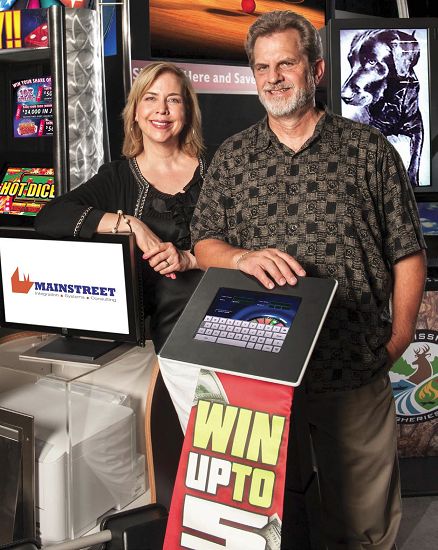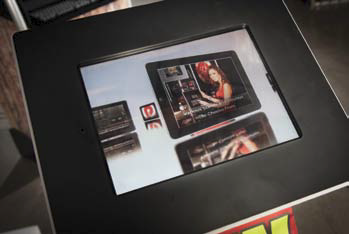Why Retail Needs Kiosk VARs ... Now More Than Ever
By Matt Pillar, Business Solutions Magazine
A growing trend in omni-channel retailing spells huge opportunity for kiosk-wielding VARs.

(Photos by Dan Bryant Photographs)
Mainstreet Technologies, Inc. has done a pretty good job building a brand name in the retail IT channel. The company typically finds itself on the short list when nationwide retailers evaluate their retail technology repair, depot, staging, and integration service options, due in no small part to the fact that it services POS and peripheral equipment from a who’s who of leading vendors (see the installation profile on this page). While its reputation for maintenance and depot services precedes the company, a significant share of its growth over the past 12 months has come from a different source, one that VP of Marketing Debbie Simurda says is just beginning to show its potential. Retail kiosks and digital signage, which are seeing rapid adoption on the heels of retailers’ rude awakening to the realities of consumerization, have injected Mainstreet with a new and quickly growing stream of business from some very impressive national brands. This is the story of Mainstreet’s venture into building and implementing custom kiosks for retailers, why it made sense for the company to invest here, and the market drivers behind the opportunity.
“There Was A Need, And We Had The Parts”
Mainstreet’s kiosk solution — dubbed digitalMainstreet, was a natural progression for the company, born of a customer’s simple need. When a major national footwear manufacturer with a strong in-store brand presence determined that kiosks were in order to support its omni-channel inventory availability effort, it seemed a no-brainer that Mainstreet should get involved. A look at that aforementioned vendor partner list reveals all the makings of a retail-hardened, self-service kiosk — from purpose built, solid state, and fanless point of service hardware and touch screens to peripherals like scanners and receipt printers. All Mainstreet needed was a means of manufacturing creative kiosk enclosures, and a new sales opportunity would be born. The integrator quickly solved that need by partnering with Ideas@Retail, a builder of POP (point of purchase) displays and kiosk enclosures. Simurda says Ideas@Retail demonstrated an ability to manufacture creative, custom-built enclosures that matched the custom-built functionality developed by Mainstreet. The result — a shelf-level kiosk that promotes the footwear manufacturer’s products in partner retail stores — has resulted in an average 25% increase in sales in stores where the unit is implemented.
On the heels of that implementation came another big kiosk opportunity, this time with another leading specialty store chain. There, Mainstreet and Ideas@Retail have implemented two kiosks in each of the company’s 50+ stores — one at the checkstand and another in the shelving department. Mainstreet’s seamless integration of color laser jet printers in the checkstand kiosk solution allowed the retailer to offer its customers personalized functionality. Looking ahead, Mainstreet plans to integrate Epson’s new inkjet technology into its kiosk offering.
Consumerization Of Retail Drives Opportunity
The driving trend behind the success of digitalMainstreet is retailers’ comprehensive struggle to serve customers in this new age of consumerism. Just a few years ago, retailers were in control of virtually every aspect of the shopping experience. Consumers were held somewhat captive to retailers’ inventory availability and pricing decisions, with little access to product data, availability information, and competitive pricing. Today, thanks to a mobile revolution that came on faster than even the best analysts’ expectations, the consumer is in the driver’s seat of the retail experience. With instant mobile access to more product and price information than most store associates, consumers have put retailers on their heels. This has fueled an urgent need for retailers to adopt tech solutions that cater to the consumer by engaging them interactively, creating endless aisles through the connection of inventory repositories that were once channel-specific, and communicating offers and promotions at the shelf level. The growth of the kiosk and digital signage market is a hallmark of that sudden and urgent need. NextGen Research suggests that the kiosk market will grow from an installed base of the 1 million units we saw in 2009 to more than 2.5 million units worldwide in 2014. Research from IHL Group backs those figures. In its North American Self-Service Kiosks Market Study, IHL said transactions at self-service kiosks are growing more than 10% per year in North America, with transactions expected to grow past $1.1 trillion per year through the devices by 2015. VARs and integrators are playing a key and profitable configuration and deployment role in this explosive growth.
Creating Profit In A Commodity Market
Mainstreet maintains that its custom-built kiosks are competitively priced in a market that’s somewhat commoditized by the PC, but it maintains a healthy profit margin through strategic sourcing and competitive differentiation. “The early rush to place kiosks in retail resulted in many failed deployments as end users chose PC-based solutions that weren’t up to the rigors of retail,” says Simurda. “The cleanest retail environment is dirtier and more abusive than the dirtiest office environment, so consumer-grade technology doesn’t hold up.” Reg Thomas, executive VP and owner at Mainstreet, says the historical failure rate of PC-based kiosks is central to the retailhardened solutions pitch that Mainstreet has developed, backed by CPUs with a POS pedigree that boast solid state drives and fanless enclosures. “Self-service devices are not like POS lanes. If a POS station fails, the associate can shut it down and move to another lane,” explains Thomas. “If a kiosk fails, the customer bears the burden and develops a negative perception as a result. So we educate retailers on the TCO (total cost of ownership) of the kiosk — usage and abuse expectations, the resulting failure rate, and how much downtime they can expect from a consumer-grade foundation.”
In comparison to a PC-based solution, one might assume that a kiosk built to custom specifications and using premium hardware from the likes of Epson, Fujistu, and HP would come with a much heftier price tag. Not so, says Thomas. “We do compete with kiosk solutions built around Dell PCs, and those units are somewhat less expensive than our offering, but not much,” he says. “We’re able to leverage the volume of the components we buy for our maintenance, depot, and integration services to create a competitive price with a healthy margin.” And, he says, retailers in the midtier niche Mainstreet set its sights on are willing to pay for customization that differentiates their kiosks. “Because we have a strong partnership with Epson, for instance, we’ve been able to customize kiosk functionality right down to the printer while maintaining a competitive price point.”
Evolution Of The Kiosk Sales Strategy
Early kiosk wins at Mainstreet came from having a foot in the door through its maintenance and depot services, which Simurda says gave the company a leg up in its understanding of a store’s needs. “We make a concerted effort among existing customers to look for digital device sales opportunities, then apply what we already know about their technology, their culture, and their store layouts when we pitch,” she says. Among those customers, the company finds itself in a good position given its history as a service provider. Now, with a few high-profile kiosk deployments under its belt, Mainstreet is honing a sales strategy that works in the other direction. “When we get a new kiosk client that doesn’t use or know our core services, those services become a natural extension of the kiosk deployment,” says Simurda. “They buy the custom-built units, and two or three years’ worth of maintenance from the company that engineered and deployed them makes perfect sense.”
As it’s expanded its product offering, Mainstreet has also had to expand its sales savvy. Ironically it’s retail IT departments — which employ the core decision makers for traditional Mainstreet maintenance and depot offerings — that present some of the biggest obstacles in the company’s new strategy to pitch kiosks to merchandisers and marketers. “In the early part of a kiosk engagement, the IT department expects to be burdened by the new store-level technology,” says Thomas. He says it behooves the sales process to make the effort to bring IT along by selling them on the idea, allaying their concerns, and making them a part of the solution. “In the end, if we can meet the specifications and price expectations of the merchandisers and marketers, we’ve typically cleared their approval. It’s the marketers that usually have the budget and the authority to buy.” To that end, Simurda says the partnership with Ideas@Retail has been instrumental to learning how to sell to retail marketing departments.
Mainstreet prides itself on the knuckle-busting maintenance and depot services that remain the foundation of its business, but a solid chunk of the estimated 15% growth it will enjoy this year comes from the sale of its new digitalMainstreet solutions. With a little help from its partners, the company had to look no further than its existing product lines and expertise to build a new market in an industry that’s hungry for self-service and interactive technologies.

